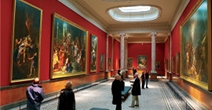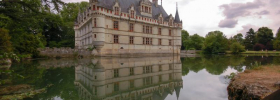 Home
Home- > Tours
- > Picardie
- > Aisne
- > Chateau-thierry
- > Château-thierry city
Château-thierry city
| Topic | Sciences and discovery |
| Departure | CHATEAU-THIERRY (02) |
| Details | The city owes its name in Thierry IV, last merovingien king, who was locked up there by Charles Martel, thus marking the advent of the Carolingian dynasty. Castle-Thierry is the birthplace of Jean of the Fountain and is located in the area of the battles of the Marne. |
Château-Thierry, city of History, city of Champagne

One hour away from Paris, 45 minutes from Disneyland Resort Paris, 30 minutes from Reims, Château-Thierry combines the assets of a major city, with its various services and tourist attractions, and the charm of the countryside. Located on the Paris-Strasbourg railway line, served by the A4 highway, the city is in many ways a crossroads.
The most famous fables writer, Jean de la Fontaine, whose fame shines forth in the whole world, was born there in 1621.
Today, after going through the 20th century wars, known both terrible and deciding battles, it has grown richer with monuments joining an extensive historical inheritance : Medieval castle, monument honoring American soldiers, former hospital holding the Hôtel-Dieu’s treasure, 15th century church, and protestant church: Château-Thierry is a many-sided city.
On its hillsides grows the grape which will become a Champagne with enchanting flavors. The vineyards offer changing colors, depending on the season, but their beauty is constant. Visiting the Champagne cellars dating from the Middle Ages enables to understand more clearly how this precious nectar is made, in a mythical setting.
Coming to Château-Thierry is the guarantee to have a pleasant stay, follow in the footsteps of key figures of our History, enjoy the proximity of major cities and appreciate the peace and quiet of a welcoming town.
Accommodation nearby
The museums of Château-Thierry


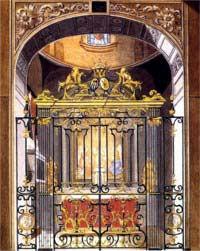
- JEAN DE LA FONTAINE MUSEUM
At the foot of the old castle, in a narrow street bordered with old houses, stands Jean de La Fontaine's birthplace where he was born on july 8th 1621.
He lived there until 1676, when he sold it to Antoine Pintrel.
It now belongs to the city of Château-Thierry and displays some original letters, editions of his fables, artifacts, artmasterpieces illustrated by artists such as Chauveau and Chagall.
- HOTEL-DIEU TREASURY
Founded in 1304 by Jeanne de Navarre, destroyed and rebuilt in 1876, the establishment is no longer used as an hospital : a modern one replacing it in 1983.
During the XVII century, its benefactor, Pierre Stoppa, Lieutenant General of Louis XIV's army, made generous donations to the Hôtel-Dieu, at the time under the priorship of his goddaughter Anne de La Bretonnière.
It displays numerous pharmacy pots, earthenware, signed furniture, a remarkable XIV century antependium and beautifuly embroidered XVIII century sacertotal attire.
nota : antependium is front of altar embroidered tapestry
Accommodation nearby
Hikes in town centres


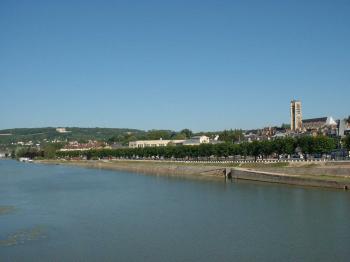
Main elements related to the history of Château-Thierry : the Marne river and the hill where its castle stands.
Noticeable above the city roofs, the steeple of Saint-Crépin church, the belfry of Balhan Tower, the slated roof of City Hall ...
Many monuments will catch your interest, Saint-Peter's gate, Eastern Ramparts, Jean de La Fontaine Statue and the city flower gardens, which won a "Three Flowers" award.
A Benedictin Abbey used to stand in the old town. It was completely destroyed, its name only is now remembered.
The banks of the river Dolloir are a place of inspiration for the nature painters.
Also worth seeing the "Ozanne" bridge, also named "pont aux Anes" (donkey bridge), last remnants of an antique bridge.
Walking along the pedestrian street enables you to better appreciate the originality of the town.
The steeple and the north gate of the present church, "Saint-Martin d'en Haut", show the mark of the Renaissance Period.
On the banks of the river Ourcq and its canal, the town centre offers the Mail promenade, with access by a metal bridge built by Gustave Eiffel.
On each side of this bridge and of the lower part of the old fortified walls, the gardens of the Sconin family estate, forefathers of Jean Racine, can be seen, as well as those of Hericart estate, where Jean de La Fontaine was married.
The old houses, the old streets, all this reminds us that this town inspired many painters, such as Corot and his disciple : Eugène Lavielle.
Rows of houses built alongside a hill are typical of this village, with its church and its steeple standing on top of the hill.
In the village centre is a famous sculpture, honoring Léon Lhermitte, XIX° century painter, born there in 1868.
His drawings and paintings are a testimony to the spirit of the rural and hardworking people he grew up among.
Facing Mont-Saint-Père stands the "Rû Chailly" farm in Fossoy. It was a place of inspiration for the painter, and is visible on a famous painting "the Pay of the harvesters", now displayed at the Orsay Museum in Paris.
The Jean de La Fontaine Museum displays a remarkable painting by the artist : "Death and the woodcutter".
Accommodation nearby
The abbays and Monasteries


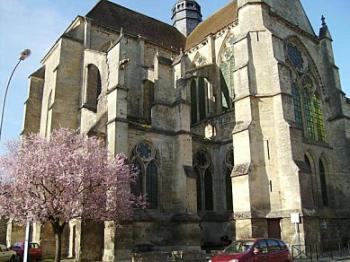
- Cerfroid in Brumetz
Founded in 1193 by Jean de Matha, the Holy Trinity Order devoted his time during centuries for the redemption of prisoners.
From the XIII° century up to the French Revolution it remained the community centre of the congregation.
Sold as national property, it was bought in 1867 by Trinitary Calixte de La Providence. In 1944 the Trinitary Nuns from Valence make it their home, followed in 1986 by the Trinitary Monks, restoring to the monastery its religious activities.
The Trinity House of Cerfroid, installed amid ancient ruins, is now a place of prayer, meeting and faith.
- Clarisses Abbey - Nogent-l'Artaud
Founded in 1299 by Blanche d'Artois, Countess of Champagne and Brie, for the redemption of her two husbands and herself, this Royal Abbey was a branch of Longchamp Abbey, under the protection of Saint Louis.
Destroyed in 1452, sold in 1792 as national property, part of it belongs to the association "Historical Nogent" aiming at a better knowledge of the site and of its history.
- Abbatial church - Essômes-sur-Marne
Founded in 1090 by Hughes de Pierrefonds, by the Saint Augustin Monastic Order, it is consecrated to the Holy Virgin.
After a three weeks siege by the English, the monks beat them on september 18 th 1370, Saint Férréol day, name given then to the church.
The church is a gothic style monument with imposing proportions.
In the choir, are 38 stalls Renaissance style. In the south transept is a XVI° century chapel, enclosed by pillars
Accommodation nearby
River boating


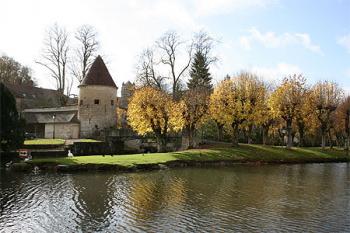
The company "Un canal, deux canaux" is located at Silly-la-Poterie, near La Ferté-Milon.
A river cruise, including lunch, will take you along the Ourcq canal, dug mid-hill eleven metres above the river Marne level, or along the Clignon canal. From there you will be able to see the ancient Commandery of the Templar Knights at Moisy , then will cross the picturesque canal-bridge above the Ourcq river.
Accommodation nearby
VTT tours



Time of the Fountain, drawing the savour of its fables through its load of Master of National Forestry Commission, of pretty fauvelets matured in the wine storehouses of the vine growers.
Now, the ways traced through the Champagne vineyard distil the pleasure of the vetetist randomly valleys of Surmelin, the Marne or that of the Parer. These names sing the promptness of water which sourdent limestone. The other with dimensions of the vine, it is a region of low horizons, on almost arid fields, where scintillate of the glares of white broken stones of the Paris basin.
Accommodation nearby
Latest news on : Château-Thierry city
Tourism near
 Visit the city of Chateau-thierry
Visit the city of Chateau-thierry - 2 Museum
- 1 Monuments
Tours
 Condé-en-Brie
Condé-en-Brie
 Dormans, the hills of the Marne
Dormans, the hills of the Marne






















